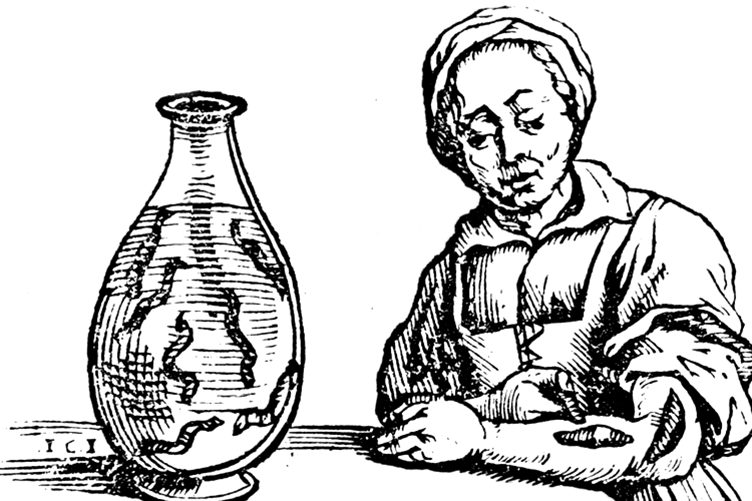
Credit: Historia Medica by W. van den Bossche, 1638, public domain, via Wikimedia Commons
Bloodletting with leeches seems a very primitive practice. So, it may surprise you to know it’s still very much in use today.
There are 700 species of leech. Most dwell in water and drink blood from fish, turtles, ducks, frogs and other creatures. Scientists can even track which animals are living in swamps and rainforests by capturing leeches and DNA testing the blood in their stomachs.
Leeches were first used in medicine at least 2,500 years ago. They became so popular in nineteenth-century Europe that overharvesting made them threatened.
Today, we’ve recognized that leeches do in fact have surprising medical benefits.
When they bite to extract blood, they inject over 60 compounds in their saliva that work as blood thinners, anti-inflammatories, antimicrobials and anesthetics. We’ve synthesized several of these and use them widely.
We even still use the leeches themselves. In the U.S., they’re approved as medical devices!
When surgeons reattach extremities like fingers or hands, leeches can be used to slowly drain blood that otherwise might pool and become deoxygenated.
Tests have found that natural anesthesia from leeches is highly effective in controlling pain from joint diseases like rheumatoid arthritis. And they’re used for treating vein disease as well.
So, if you need a medical procedure in the future, don’t be too surprised if your doctor prescribes leeches!
Background
Synopsis: For most people, the thought of leeches can be frightening because most of these cousins of earthworms evolved to consume blood. They are not dangerous to humans; in fact, they have been used in medicine for more than 2,500 years and are classified as medical devices by the USDA. These creepy crawlers also provide benefits for genetic and biodiversity research.
- Leeches are annelid (segmented) worms and are closely related to earthworms. Both belong to the phylum Annelida, class Clitellata, but earthworms belong to subclass Oligochaeta, while leeches belong to subclass Hirudinae.
- Although they are soft bodied, leech fossils are well known from the Jurassic Period (150 million years ago). However, fossils found in Wisconsin suggest they may have evolved as long ago as the Silurian Period (437 million years ago).
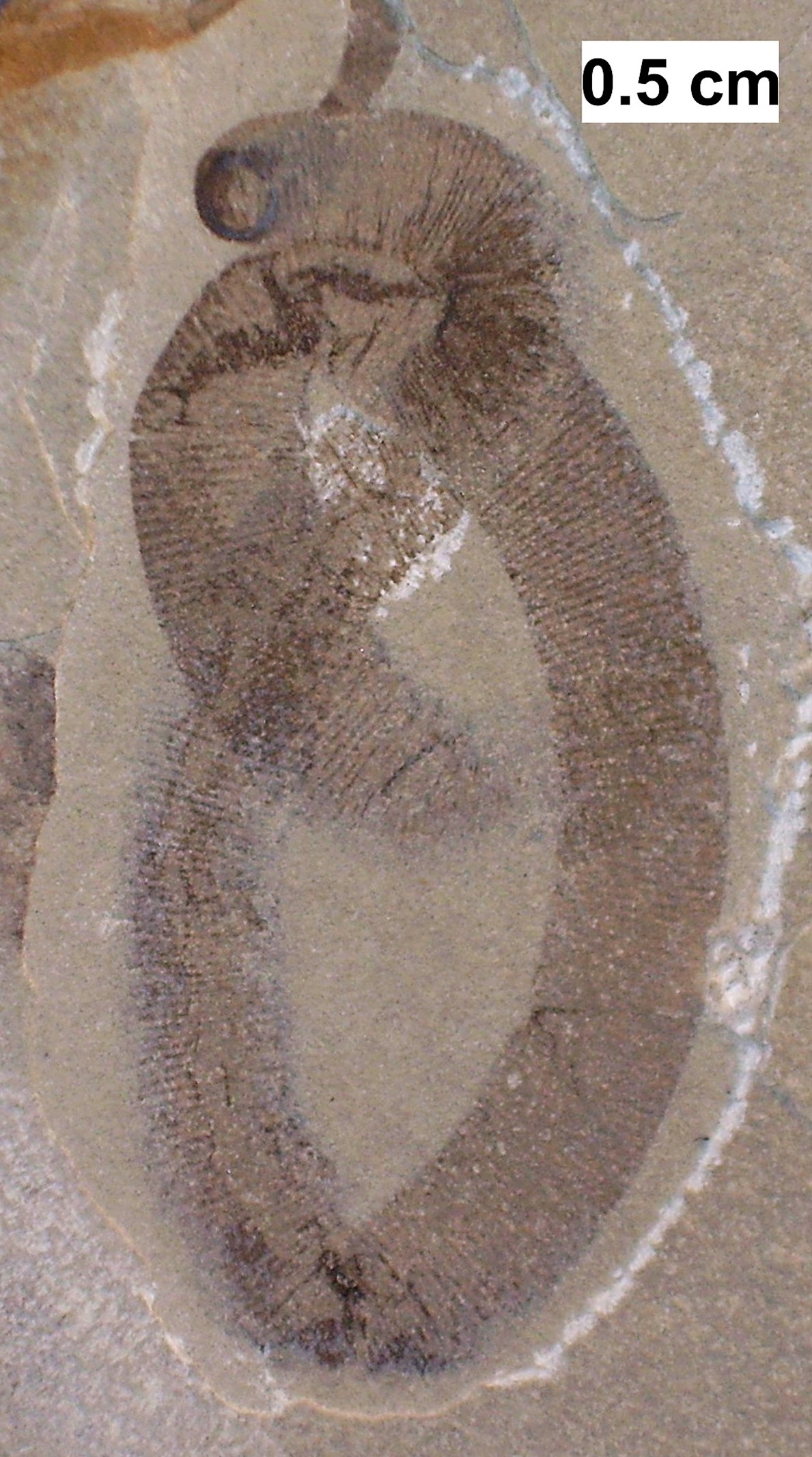
Silurian worm with external ring markings and a large sucker, probably a leech, from the 427-million-year-old Waukesha Biota Brandon Bridge Formation in Waukesha, WI; UWGM 2422.
Credit: Wikimedia Commons - Today, there are nearly 700 species of leeches that live on six continents (excluding Antarctica). Of those, around 100 are marine, 90 are terrestrial and 500 are freshwater dwelling.
- About 75% are sanguivores that must consume blood to survive, commonly attaching to fish, turtles, amphibians, ducks, small mammals and livestock. The remaining 25% hunt and kill their prey, including small invertebrates, snails, slugs, and their earthworm cousins.
- They are most common in still, shallow bodies of fresh water. Under the right conditions, up to 1,000 may be found per square foot.
- Although they are soft bodied, leech fossils are well known from the Jurassic Period (150 million years ago). However, fossils found in Wisconsin suggest they may have evolved as long ago as the Silurian Period (437 million years ago).
- Most leeches grow to 3–4 in (7–10 cm) in length, but the Amazonian giant leech may grow to more than 16 in (40 cm).
- The most obvious difference between earthworms and leeches is that leeches have suckers at both ends of their body, with the back sucker used for locomotion.
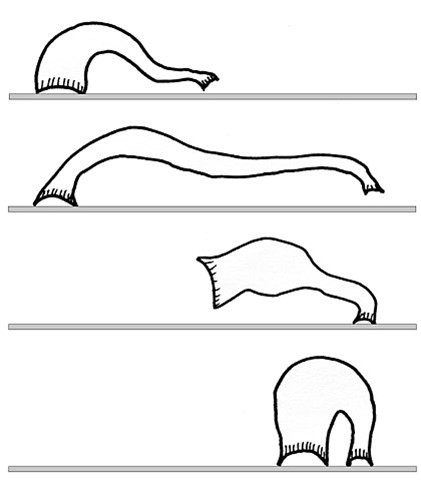
Leech locomotion using suckers at each end.
Credit: Chiswick Chap, via Wikimedia Commons - The front sucker is equipped with tripartite jaws that look like tiny saws with around 100 sharp edges that leave a Y-shaped incision inside a circular spot where they inject a pain killer and an anticoagulant called hirudin.
- Individual leeches can consume up to ten times their body weight in a single meal, usually around 5–15 mL, and can live a year between feedings.
- Leeches are not dangerous to humans or animals but can cause complications in livestock if they attach to mucous membranes and block breathing.
- The most obvious difference between earthworms and leeches is that leeches have suckers at both ends of their body, with the back sucker used for locomotion.
- Leeches have been referenced in medical texts for at least 2,500 years, particularly the species Hirudo medicinalis.
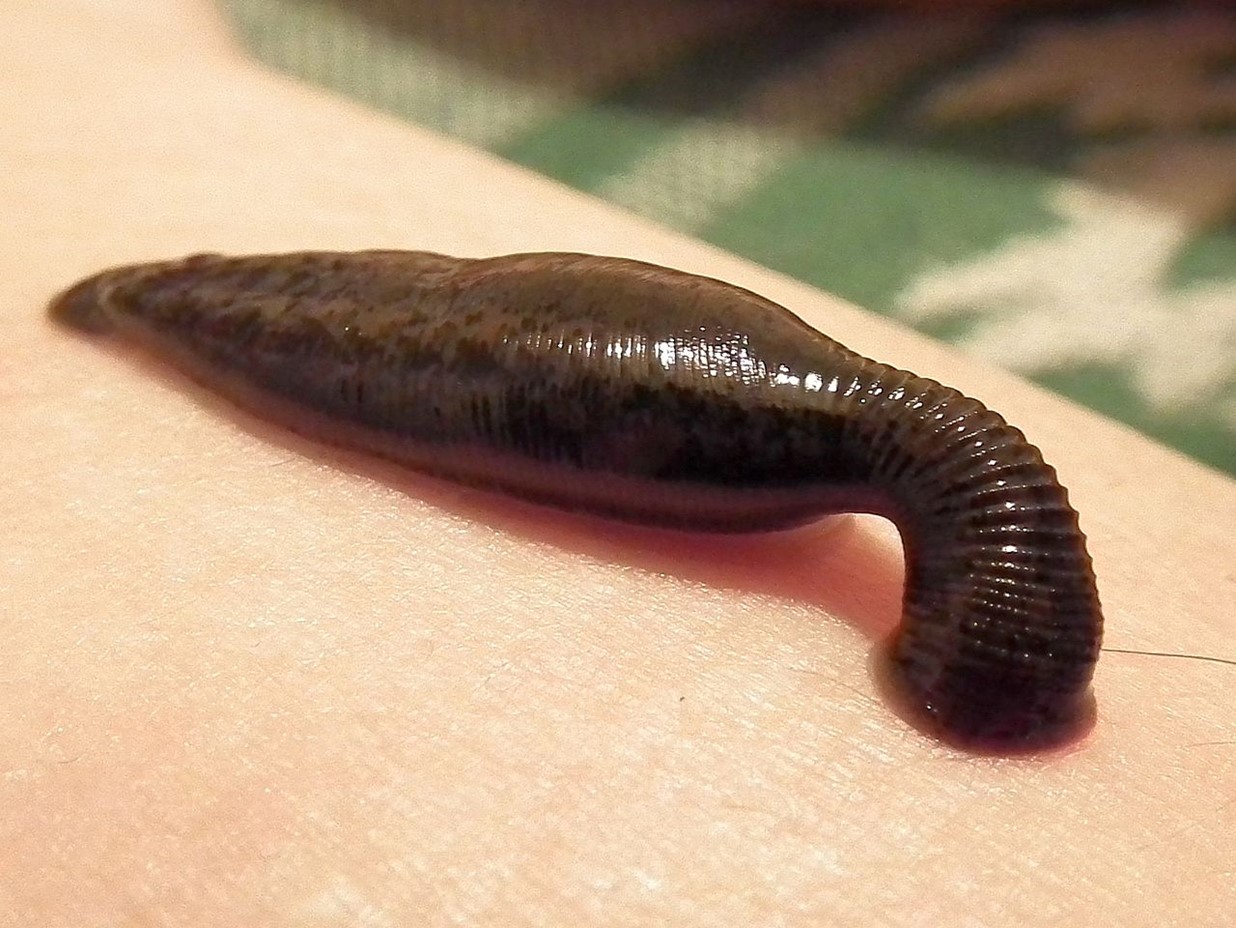
Medicinal leech (Hirudo medicinalis) attached to human skin.
Credit: GlebK, via Wikimedia Commons- The fifth-century BC Hippocratic Corpus, a collection of about 60 medical works from around the time of Hippocrates, details the theory of balancing the four “humors” (blood, phlegm, black bile and yellow bile), using bloodletting with leeches to reduce inflammation, fevers and headaches.
- In the Sushruta Samhita, an ancient Indian Ayurvedic medical text in Sanskrit, their use was suggested for skin diseases, musculoskeletal pains and sciatica.
- Pliny the Elder, who died in AD 79, noted that leeches were used in the treatment of gout in ancient Rome.
- In Old English, the word for physician was the same as the word for leech, and the art of healing was known as leechcraft.
- By 1830, leeches were so popular in European medicine that their demand exceeded their supply and they needed to be imported or farmed. France used as many as 30 million per year.
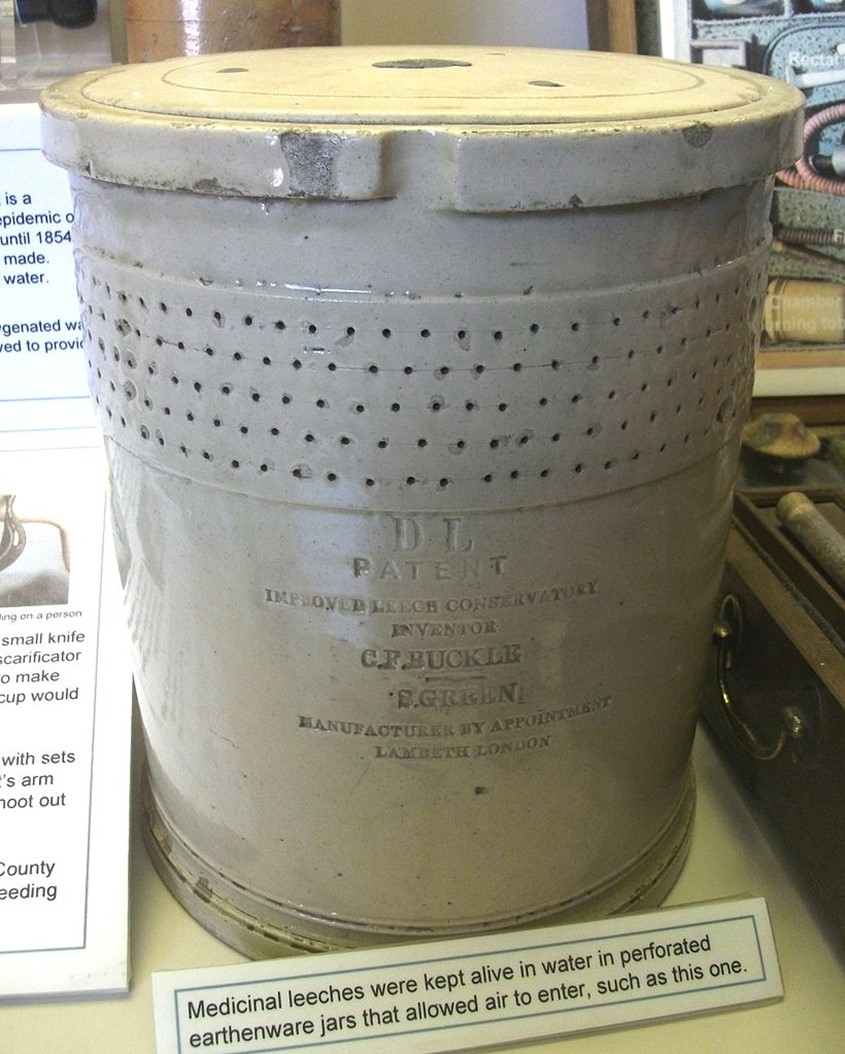
A jar for keeping medical leeches on display at the Bedford Museum in eastern England. Leeches were submerged in water and exposed to air through the holes in the top of the vessel and could live for nearly a year between meals.
Credit: Simon Speed, public domain, via Wikimedia Commons - Nineteenth-century leech collectors overexploited leech habitats, resulting in scattered populations. Ultimately, Hirudo medicinalis has been designated near threatened by the IUCN, with their natural range protected.
- Today, leeches are bred for medical use at specialized leech farms, are sanitized before attachment, and are discarded as medical waste after use.
- Medicinal leeches have long provided medical researchers with a wealth of bioactive substances secreted in their saliva, including around 60 different proteins that help the leech to feed, ranging from anticoagulants to anti-inflammatories to antimicrobials to anesthetics.
- One of the most important is an anticoagulant known as hirudin that keeps the blood flowing for the leech’s meal. Today, it is widely synthesized using recombinant DNA technology for the treatment of blood clotting disorders.
- Others like apyrase, collagenase and calin are platelet aggregation inhibitors.
- Leech saliva also includes vasodilators, which dilate or open blood vessels, and proteinase inhibitors, important proteins used in medicine.
- Some of these compounds enable growth of new capillaries and veins.
- Leech saliva includes a natural anesthetic—leech bites are not painful, so may go unnoticed.
- In 2004, the USDA recognized leeches as living, breathing medical devices.
- Today, leeches are used to prevent tissue death, especially in cases of reconstructive microsurgery to reattach extremities like hands or fingers right down to their microscopic capillaries.
- Leeches withdraw excess blood and inject blood thinners to prevent clotting, causing slight but steady bleeding that relieves venous congestion, which is a pooling of blood in the injured tissue that may deoxygenate if it stagnates, damaging injured tissue.
- Essentially, leeches act as surrogate veins to remove the blood until capillaries and vessels have regenerated or healed enough to keep the tissue alive.
- Each leech feeds for about an hour. A patient may require more than 200 of the animals for the duration of the treatment, and they must be monitored to ensure they stay on injured tissue.
- “Mechanical leeches” have been developed to slowly dispense heparin into wounds and suction away blood, but they are not yet widely available.
- Leeches are also being used for other medical purposes.
- The natural anesthetic and anti-inflammatory compounds in leech saliva has inspired applying leeches to treat joint diseases like osteoarthritis, outperforming anti-inflammatory gel in pain relief and decreased stiffness.
- Leeches may be used to treat varicose veins, blood clots and vein diseases in the extremities.
- Leeches also benefit genetic research. Scientists studying the differences between leeches and earthworms hope to identify the genes that enable earthworms to regenerate.
- If you accidentally cut an earthworm in half with a shovel in your garden, it will regenerate into two earthworms. But if its cousin the leech is chopped in half, you just get a dead leech. What is the genetic difference that allows regeneration?
- This work may help us to understand how certain animals, like many amphibians, evolved to regenerate limbs while others, like mammals, cannot.
- Over the past decade, researchers have experimented with using leeches to collect data about biodiversity, with study areas in the tropical rainforests of Vietnam and China.
- In a previous EarthDate (ED-282 Out of Thin Air), we talked about collecting environmental DNA (eDNA) from the air in zoos and concentrating it using Polymerase Chain Reaction (PCR) methods to catalog the range of animals in the environment.
- These bloodsuckers attach themselves to hosts, effectively collecting their DNA so researchers can monitor biodiversity without having to disturb the wildlife.
- In China, rangers collected more than 30,000 leeches and detected 86 species ranging from bears to cattle to frogs and humans.
- If a leech latches on to you, do not rip it off. You may leave its mouth parts embedded in your skin, which is prone to causing an infection.
- Sprinkle the leech with salt or heat it with a hair dryer to get it to release and drop off on its own.
- Then, clean and disinfect the wound and cover it with a bandage.

Don’t do this! Rose (Kathryn Hepburn) frantically tries to remove leeches from Charlie’s (Humphrey Bogart’s) body in a scene from the 1951 film The African Queen (cinematography by Jack Cardiff).
Credit: The African Queen, John Huston, 1951

